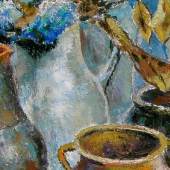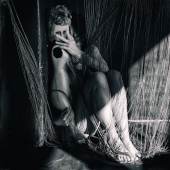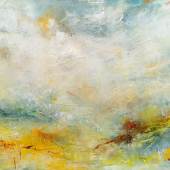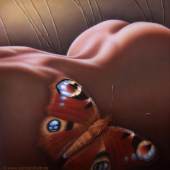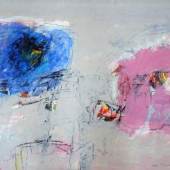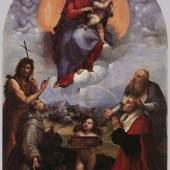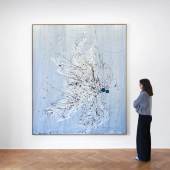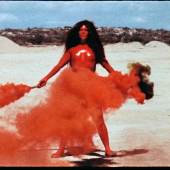Fondazione Giorgio Cini
Expanded Horizons: American Art in the 70s
-
Ausstellung21.09.2024 - 25.01.2025
I think a painting is more like the real world if it's made out of the real world.
— Robert Rauschenberg
Expanded Horizons features artists who engaged with the ‘real world’ by integrating found objects into their practice, challenging contemporary definitions of what could be considered art. Rauschenberg’s Cardboards (1971–72), which he created in his then-newly opened studio in Florida, are made from found boxes that he cut and reassembled to form a wall sculpture, or stacked to form a freestanding installation. The artist’s later Bank Job, meanwhile, features as a central element a white shirt, collaged with its arms outstretched. In the artist’s own words, ‘a pair of socks is no less suitable to make a painting than wood, nails, turpentine, oil and fabric’.
Joan Snyder (b. 1940), who acknowledged Rauschenberg’s influence on her work, incorporated found materials such as chicken wire and fake fur whose tactile materiality creates a visceral sense of an implied narrative: that of the artist’s own experience of moving through the world. A John Chamberlain (1927–2011) sculpture belonging to his most notable series of works assembled from found scrap automobile metal is shown alongside a copper work by Carl Andre (1935–2024). Andre, who made sculptures made from ordinary industrial materials, arranged on the floor in simple linear or grid-like compositions, passed away earlier this year. After Irving Penn’s (1917–2009) mentor and fellow photographer Alexey Brodovitch died of cancer in 1971, Penn began his best known series, Cigarettes, collecting discarded cigarette butts from the streets and taking them back to the studio. There, he carefully laid them out to produce photographic compositions, which elevated them from litter to art object, while uncannily personifying them in a comment on a society damaged by corporate irresponsibility and governmental negligence.
By working with scrap materials in their original condition, complete with stains, defaults or dirt, these artists draw attention to the character of the material itself. Other artists create a similar effect through paint, using expanses of uniform colour to highlight their medium’s specific qualities, exploring notions of surface, space and light. Robert Ryman (1930–2019) encourages an examination of the surface and boundaries of the picture plane by painting it entirely in white-on-white: ‘I am not a picture painter. I work with real light and space’. His use of white across different supports – in the work on view, he layers gloss paint atop PVC – draws attention to their materiality rather than concealing it. When asked by Phyllis Tuchman for May 1971’s Artforum whether he made white paintings, he explained: ‘No, it may seem that way superficially, but there are a lot of nuances and there’s color involved. Always the surface is used.’ Judd’s deliberate use of colour, which he viewed as something physical – a concrete formal entity – conveys the shape of his objects, lending definition to their planes and edges. By painting expanses of the work on view in blue, he brings together its colour and its spatial dimension: ‘Color and space occur together’, as do light and space in the work of Dan Flavin (1933–96).
Rosenquist’s installation rejects figurative imagery, alternating canvases painted with planes of flat colour with panels stretched with reflective silver Mylar film to create, in the artist’s words, ‘color as a state of mind’. Similarly, in paintings by Lovelace O’Neal and Snyder, panel-like blocks of colour which seem to jostle within the picture plane as if competing for room allow for a more focused meditation on surface, space and texture, from Snyder’s pastose application to Lovelace O’Neal’s expressive brushwork, reconciling the intimate and the monumental, encouraging at once a focus on intricate materiality and a sense of its place as part of a wider vision. As Snyder explained: ‘I wanted more in painting, not less’. Both Lovelace O’Neal and Snyder worked against the conventions of male-dominated contemporary Minimalism and Colour Field painting to explore the scope of abstraction to explore deeply personal and wider sociological narratives related to their lived experiences of womanhood, and, in Lovelace O’Neal’s case, Black womanhood, in 1970s America.
In 1970, self-described ‘paintersculptor’ Rosemarie Castoro moved away from her previous colourful paintings in protest against the Vietnam War to dedicate herself to monochrome sculptural experimentation. The monumental works on view were made by applying gesso, modelling paste and marble dust to Masonite panels, giving the works a distinctive gritty yet refined texture. Castoro’s approach to artmaking was also informed by her background in dance, exhibiting a distinctly performative character and understanding of space and movement. With paintings depicting dancers, both Joan Brown and Alex Katz (b. 1927) bring this same sense of depth and movement into the two-dimensional realm. As Katz recounts in his autobiography, his collaborations with dancers and choreographers as a set and costume designer ‘expanded the idea of what I could do. You’re not just a painter, you’re a person who has an idea about the art. Once you get that through your head, you have an expanded way of dealing even with your painting.’
-
Raffael verbringt die erste Lehrzeit bei seinem Vater Giovanni Santi; er erwirbt in dieser Zeit...
-
18.05.2024 - 20.07.2025Created in the artist’s studio north of Salzburg, this new series of paintings and ink...
-
21.09.2024 - 25.01.2025Group exhibition Carl Andre Joan Brown Rosemarie Castoro John Chamberlain Judy Chicago Dan Flavin...
-
21.09.2024 - 25.01.2025Carl Andre Mary Lovelace O’Neal Joan Brown Robert Morris Rosemarie Castoro Senga Nengudi...
-
28.11.2024 - 05.02.2025Marking Joan Snyder’s first solo exhibition with the gallery, Body & Soul is...
-
21.09.2024 - 25.01.2025
Tuesday—Saturday, 10am—6pm.
